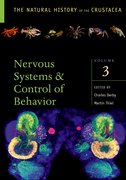New Faculty Publication: Nervous Systems and Control of Behavior
 Congratulations to Dr. Charles Derby, of the Neuroscience Institute, on the publication of his co-edited book Nervous Systems and Control of Behavior, volume 3 of the The Natural History of Crustacea series.
Congratulations to Dr. Charles Derby, of the Neuroscience Institute, on the publication of his co-edited book Nervous Systems and Control of Behavior, volume 3 of the The Natural History of Crustacea series.
From the publishers’ website:
Crustacean Nervous Systems and their Control of Behavior is the third volume of the series The Natural History of the Crustacea. This volume is on the functional organization of crustacean nervous systems, and how those nervous systems produce behavior. The volume has three sections that build progressively on each other. The first section is on the basic organizational features of the crustacean nervous system and the principles upon which it is built. The second section is on sensory ecology – the organization of each sensory system and how it is used in intra- and interspecific interactions, within an ecological context. The third section uses case studies of how crustacean nervous systems are organized to perform complex behaviors and interactions, such as walking, escape, social interactions, and memory and learning. Taken together, the 20 chapters synthesize our modern understanding of the neural control of behavior in crustaceans, based on the most recent technologies in physiological recording, molecular biology, and computational science. This volume will be useful to students and researchers as a concise summary of current knowledge of crustacean neuroscience.
Professor Derby is a Regents Professor of Neuroscience and Biology at Georgia State University who studies how animals use sensory information in solving life’s challenges, such as finding high-quality food, identifying mates, and avoiding predators. His focus has been the chemical senses of decapod crustaceans, especially spiny lobsters, clawed lobsters, and brachyuran crabs.
He is also the author of the following articles:
Derby, C.D. 2014. Cephalopod ink: production, chemistry, functions and applications. Marine Drugs 12: 2700-2730.
Kamio, M., M. Schmidt, M.W. Germann, J. Kubanek, and C.D. Derby. 2014. The smell of moulting: N-acetylglucosamino-1,5-lactone is a moulting biomarker and candidate courtship signal in the urine of the blue crab, Callinectes sapidus. J. Exp. Biol. 217: 1286-1296
Tadesse, T., C.D. Derby, and M. Schmidt. 2014. Mechanisms underlying odor-induced and spontaneous calcium signals in olfactory receptor neurons of spiny lobsters, Panulirus argus. J. Comp. Physiol. A 200: 53-76.
Derby, C.D., M. Tottempudi, T. Love-Chezem, and L.S. Wolfe. 2013. Ink from longfin inshore squid, Doryteuthis pealeii, as a chemical and visual defense against two predatory fishes, summer flounder, Paralichthys dentatus, and sea catfish, Ariopsis felis. Biol. Bull. 225: 152-160.
